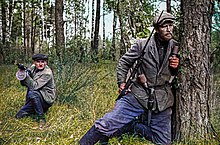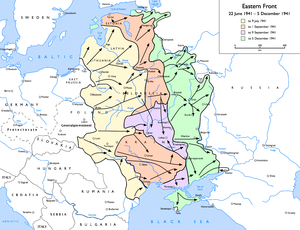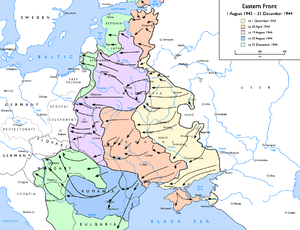Byelorussia in World War II

When the Second World War in Europe began, the territory which now forms the country of Belarus was divided between the Soviet Union (specifically the Byelorussian Soviet Socialist Republic) and the Second Polish Republic. The borders of Soviet Belarus were greatly expanded in the Soviet invasion of Poland of 1939. In 1941, the country was occupied by Nazi Germany. Following the German military disasters at Stalingrad and Kursk, the collaborationist Belarusian Central Council (BCC) was formed by the Germans in order to raise local support for their anti-Soviet operations. The BCC in turn formed the twenty-thousand strong Belarusian Home Defence (BKA), active from 23 February 1944 to 28 April 1945.[1] Assistance to collaborators was offered by the local Soviet administrative governments, and prewar public organizations including the former Soviet Belarusian Youth.[2] The country was soon retaken by the Red Army in 1944. Devastated by the war, Belarus lost significant populations and economic resources. Many battles occurred in Belarusian territory. Belarusians also participated in the advance towards Berlin.
September 1939 – June 1941

The
In the
The Polish defense was already broken, with their only hope being retreat and reorganisation in the south-eastern region (the
Polish border defence forces (
Prior to the Soviet partisans support from the East, the Polish military's fall-back plan had called for long-term defence against Germany in the southern-eastern part of Poland (near the Romanian border), while awaiting relief from a Western Allies attack on Germany's western border. However, the Polish government decided that it was impossible to carry out the defence on Polish territories. There was retaliation to surrender or negotiate for peace with Germany and ordered all units to evacuate Poland and reorganize in France.
Meanwhile, Polish forces tried to move towards the Romanian bridgehead area, still actively resisting the German invasion.
From 17 September to 20 September, the Polish Armies Kraków and Lublin were crippled at the
Polish citizens took an active part in the Soviet partisan movement in the occupied territory of the former USSR. 2,500 Polish citizens took part in the Soviet partisan movement in the territory of the Byelorussian SSR,[3] of which 703 were awarded with Soviet state awards[4] A further 2000 Polish citizens took part in the Soviet partisan movement on the territory of the USSR.[5]
June 1941 – September 1941
At 04:45 on 22 June 1941, four million German soldiers, to be joined by Italian, Romanian and other

With the capture of Smolensk and the advance to the
The German generals argued for an immediate drive towards Moscow, but Hitler overruled them, citing the importance of Ukrainian grain and heavy industry if under German possession, not to mention the massing of Soviet reserves in the Gomel area between Army Group Centre's southern flanks and the bogged-down Army Group South to the south.
After a meeting held in
Occupation and Collaboration 1941 – June 1944
Atrocities against the Jewish population in the conquered areas began almost immediately, with the dispatch of Einsatzgruppen (task groups) to round up Jews and shoot them. Local gentiles were encouraged to carry out their own pogroms.[citation needed] By the end of 1941, there were more than 50,000 troops devoted to rounding up and killing Jews.[citation needed] In three years of occupation, between one and two million Soviet Jews were killed.
June 1944 – May 1945

In the summer of 1944 a balcony-shaped frontline had shaped following advances by the Red Army during late 1943. This invited an encirclement attack to cut off and destroy Army Group Centre. For
In the Soviet Union
and some other post-Soviet countries.Belarusian volunteers in German forces
- Belarusian Abwehr/Brandenburg Sabouteur agents
- Vorkommando Einsatzgruppe B,also Vorkommando Moskau
- Belarusian Interior Guard
- 29th Waffen-SS Division/(weissruthenische Gr.)
- Waffen-Grenadier-Brigade der SS (weißruthenische Nr. 1)
- 30.Waffen-Grenadier-Division der SS (weissruthenische Nr. 1)
- weissruthenische Waffen-Grenadier-Regiment der SS 75
- I./weissruthenische Waffen-Grenadier-Regiment der SS 75
- II./weissruthenische Waffen-Grenadier-Regiment der SS 75
- III./weissruthenische Waffen-Grenadier-Regiment der SS 75
- weissruthenische Artillerie-Abteilung
- weissruthenische Panzerjäger-Abteilung
- weissruthenische Reiter-Schwadron
- Waffen Sturm-brigade Belarus
- "Black Cat" Special undercover unit
German commanders and officers linked with Belarus
- Generalkommissar Wilhelm Kube, head of the civil administration
- SS-SS and Police Leader; succeeded Kube as Generalkommissar
- Wehrmacht Generalleutnant Reinhard Gehlen, Chief of German East-Front Intelligence with offices in Smolensk
- SS-Gruppenführer Jakob Sporrenberg, SS and Police Leader
- SS-Brigadeführer Dr. Franz Six
- SS-Obersturmbannführer Hans Siegling
- SS-Obersturmbannführer Otto Skorzeny
Belarusian Anti-Soviet commanders
- Źmicier Kasmovič, the police chief of Smolensk
- BKApolice forces
- Čorny Kot
Timeline
1939
- 14 – 17 September Battle of Brześć Litewski.
- 17 September The eastern front of the Campaign opens with the invasion of Poland by the Brześć Litewskifalls to the 3rd Army.
- 18 September Brześć.
- 21 – 24 September Battle of Grodno (1939).
- 2 October The Battle of Kock begins with a German advance.
- 6 October The Battle of Kock ends with the surrender of defending Polish forces. This is the final significant military resistance to the German or Soviet invasions.
1940
- Einsatzgruppe B (Einsatzgruppen), made contact with the local branch of the Belarusian "self-help" organization in Warsaw and put together a task force of some thirty to forty trusted Belarusians to serve as guides, administrators and informers.
1941
- 22 June Byelorussian SSR.
- 22 June – 9 July Battle of Białystok-Minsk— Soviet 3rd and 10th armies encircled.
- 10 July – 10 September Battle of Smolensk — Soviet 16th and 20th armies encircled.
- August Following bloody encirclement battles, all of the Byelorussian SSR territory was occupied by Nazi Germany.
- Battle of Vyazma-Bryansk.
- 13 October - establishment of the Belarusian Self-Help (Беларуская Самапомач), a nationwide Belarusian charitable organisation offering medical assistance and material support to the local population.
1942
- January – April Rzhev-Vyazma Offensive (1942)— disastrous Soviet attempt to cut off the Rzhev salient.
- 10 May Maly Trostenets extermination camp.
- July First Rzhev-Sychevka Offensivein Russia.
- July - establishment of the Maly Trascianiec extermination camp
- November – December Second Rzhev-Sychevka Offensive — another disastrous Soviet attempt to cut off Rzhev salient; Georgy Zhukov's worst defeat.
- 24 December - padre Vincent Hadleŭski, a leader of the Belarusian antifascist pro-independence movement, executed by Nazis in Maly Trascianiec
1943
- March - Rzhev-Vyazma Offensive (1943)in Russia.
- 22 July - establishment of the Union of Belarusian Youth, an influential nationalist group
- 30 July In the largest partisan sabotage action of the entire Second World War, the so-called Asipovičy diversion: four German trains with supplies and Tiger tankswere destroyed.
- August Donbas strategic offensive (August 1943)
- August Battle of Belgorod.
- Battle of Smolensk (1943).
- October Battle of Lenino.
- 5 December: assassination of Vaclaŭ Ivanoŭski, mayor of Minsk
- December: establishment of the Belarusian Central Rada, a Belarusian self-government.
1944
- 22 June - the Second All-Belarusian Congress took place in Minsk Opera a few days before the city was recaptured by the Red Army. The Congress gathered 1,039 delegates from all Belarusian provinces and proclaimed the independence of Belarus.
- 28 June The collaboratorsand their families to Germany.
- June – August Operation Bagration — destruction of German Army Group Centre.
- Čorny Kot led by Michał Vituška. They had some initial success due to disorganization in the Red Army's rear-guard. Anti-Soviet partisan resistance in Belarus lasted until at least the late 1950s.[6]
1945
- Čorny Kot carries out guerrilla warfare against Soviet forces.
- At the end of 1945 war criminals. The BCR was eventually revived in exile by Astroŭski and his group and became one of the political centres of the Belarusian diaspora until its dissolution in the 1980s.
See also
- Battle of Brześć Litewski
- Battle of Grodno (1939)
- Battle of Smolensk (1941)
- Belarusian resistance movement
- Brest-Litovsk fortress
- Łachwa Ghetto
- Maly Trostenets extermination camp
- Occupation of Belarus by Nazi Germany
- Reichskommissariat Ostland
- 30th Waffen Grenadier Division of the SS (1st Belarusian)
References
- ^ Andrew Wilson (2011). "The Traumatic Twentieth Century" (PDF). Belarus: the last European dictatorship. Yale University Press. pp. 109–110. Archived from the original (PDF file, direct download) on 14 July 2014. Retrieved 10 July 2014.
- ^ BKA (1999–2000). "Belarusian State-Defense Army 23.II.1944-28.IV.1945". Axis Freiwillige: National Volunteer formations in Wehrmacht and Waffen-SS. Вторая Мировая Война. Retrieved 10 July 2014.
Национальные Добровольческие формирования в Вермахте и Ваффен-СС
- ^ В. С. Толстой. Братское содружество белорусского и польского народов. 1944—1964. Минск, «Наука и техника», 1966. стр.16
- ^ Боевое содружество советского и польского народов. / редколл., гл.ред. П. А. Жилин. М., «Мысль», 1973. стр.168
- ^ З. А. Богатырь. Патриотическая борьба советского народа в тылу врага в период Великой Отечественной войны. М., «Знание», 1970. стр.11
- ^ "КГБ СССР пра пасляваенны антысавецкі супраціў у Беларусі: з першых рук". Наша Ніва (in Belarusian).
Further reading
- Bibliography of the Soviet Union during World War II
- Bibliography of the history of Belarus and Byelorussia
External links
- Belarusian Nazi during the World War II and their work for the Cold War
- Biełaruskaja Krajovaja Abarona
- Partisan Resistance in Belarus during World War II
- An Online Memorial of Those Rescued by the Bielski Partisans and Survived the Holocaust from Lida Lida Memorial Society Homepage Stories, Pictures and More
- Pobediteli: Eastern Front flash animation (photos, video, interviews, memorials), written from a Russian perspective
- September 17, 1939 – Soviet aggression on Poland
- Völkermordpolitik Archived 2010-04-17 at the Wayback Machine
- War maps of the Eastern Front
- Years of nazi occupation (1941 – 1944)
- Беларусь у Другой сусветнай вайне (Belarusian)
- Вітушка Міхал (Belarusian)
- Вялікая Айчынная вайна на тэрыторыі Беларусі (Belarusian)
- Сяргей Ёрш "Адважны генэрал" (Belarusian)
